Mass Tort- Soft Baby Carrier Lawsuit Representation
Has Your Child Suffered Hip Dysplasia or Another Hip Condition After Using a Baby Carrier? Call Balaban Law Today at 303.377.3474
If your child has been diagnosed with hip dysplasia or another hip condition and has been transported in a baby carrier or sling, such as Baby Bjorn, Infantino, Graco, or Evenflo please call and speak with a member of our team as soon as possible! Expanding search has revealed that certain types of baby carriers are likely unsuitable for infants and may contribute to hip dysplasia and other hip conditions. Balaban Law is dedicated to fighting for our client and their family’s well-being, especially children. Balaban Law will hold negligent companies accountable for selling dangerous products to innocent consumers.
Contact Balaban Law’s team of experienced attorneys to discuss your case. We represent injured parties throughout the Denver metro area and we welcome the opportunity to be of assistance to you. Feel free to complete a Free Case Evaluation form on our website or call our office for a complimentary, confidential discussion regarding your case.Parent’s primary concerns are the safety and well-being of their children. Parenthood is an undertaking that involves a lot of time, work and decision-making. Oftentimes, we parents rely on the representations made to us by well-respected baby product companies to assist us or to provide products that we believe will promote a healthy and happy child.
Unfortunately, many companies take advantage of a parent’s sometimes limited ability to make informed and effective long-term decisions. Child products are regularly marketed and sold because they will provide parents with “more quality time with their children;” they will provide “convenience and ease of use;” and ultimately products sell on the promise of providing a “better and easier life” for you and your child.
Parents should and do expect manufacturers to sell products that are safe for their children, especially when the product comes from an established and well-respected company. Unfortunately, children’s products are often defective or pose dangerous risks, which parents only discover after their child has been injured.
If you have used a soft baby carrier, such as Baby Bjorn, and your child is now experiencing hip problems, you may be entitled to receive compensation for your child’s pain and suffering, as well as for all expenses incurred due to the child’s injury.
Free Case Evaluation Baby Bjorn Original Carrier
Baby Bjorn Original Carrier
Several baby carriers and slings have been found to be inadequate based on health care professional’s recommendations for healthy infant hip development.
Note: Even if your child has not been diagnosed with a hip condition, but you have used any of these carriers extensively, you should schedule an appointment with your child’s medical professional. Hip Dysplasia and other issues are sometimes hard to detect and might have affected your child without your knowledge.
Note: Even though some of these baby carrier products have been discontinued, this does NOT mean your potential claim is prohibited. If you have used any of these products or other baby carriers and your child is suffering from a hip dysplasia issue, speak with one of team members today to discuss your child’s possible legal options.
If you have transported your child in any of the following carriers and your child has a hip injury diagnosis, call Balaban Law as soon as possible:
- Baby Bjorn – Baby Carrier Original
- Britax ⦁ Baby Carrier
- Budu ⦁ Baby Carrier
- Chicco – ⦁ UltraSoft ⦁ Infant Carrier
- Evenflo ⦁ – Breathable Carrier
- Evenflo ⦁ – Easy Infant Carrier
- Evenflo ⦁ – Active Carrier
- Evenflo ⦁ – ⦁ babyGo
- Evenflo ⦁ – ⦁ Snugli ⦁ Comfort
- Graco – Soft Infant Baby Carrier
- Infantino – Swift Classic Carrier
Baby carriers that force a child’s legs into a straight or dangling position are unhealthy. When being transported in a carrier, a baby’s hips should be spread apart and bent, almost in a squatting position.
“Parents and caregivers are encouraged to choose a baby carrier that allows healthy hip positioning, in addition to other safety considerations. When babies are carried, especially for prolonged periods of time, the hips should be allowed to spread apart with the thighs supported and the hips bent.”
Free Case Evaluation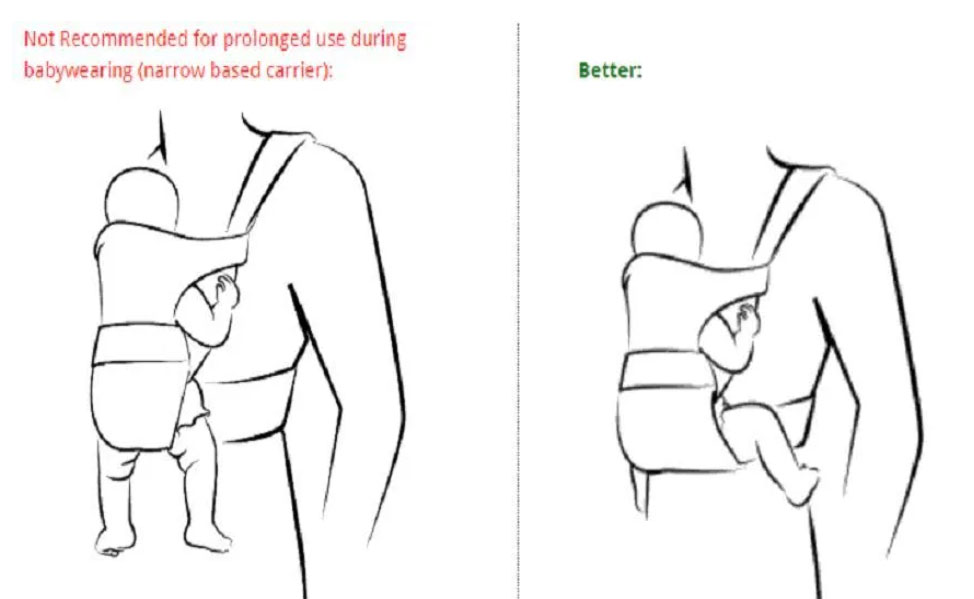
The International Hip Dysplasia Institute has published extensive information about baby carriers and slings. Their conclusions are that some baby carriers force infants into unhealthy hip positions, which can lead to hip dysplasia or other hip conditions. According to the Hip Dysplasia Institute:
“There is evidence that carrying a baby on the mother’s body (or father’s body) is likely to influence hip development during the first six months of life when the baby is carried for many hours each day for purposes of bonding, or infant care.”
Infant Development
After a child is born, his or her joints remain soft and malleable. It takes months for the joints to stretch out naturally and become firmer. For newborn children, the ball of their ball and socket hip joint is loose and the edges are made of soft cartilage. This means that the joint can bend easily.
If a child’s legs are forced to stretch out straight for too much time, it can cause the hips to dislocate.
This dislocation of the hip is rarely painful in infancy. Just like the soft cartilage in our ears, bending that area of the body might not cause pain. However, the effects of hip dysplasia often become apparent when the child begins walking. The condition can also lead to painful arthritis in adulthood.
According to the International Hip Dysplasia Institute, for improper baby carriers (indicated in the diagram on the left): “Thigh NOT supported to the knee joint. The resulting forces on the hip joint may be inappropriate for prolonged use when infants have loose hip joints or hip dysplasia.”
For proper baby positioning (indicated in the diagram on the right): “Thigh is supported to the knee joint. The forces on the hip joint are minimal because the legs are spread, supported, and the hip is in a more stable position.”
The International Hip Dysplasia Institute (IHDI)
See the images below, published by The International Hip Dysplasia Institute, which demonstrate healthy and unhealthy positions for babies in their carriers. The diagram on the left portrays improper baby positioning, while the diagram on the right displays healthier positions for infants in carriers:
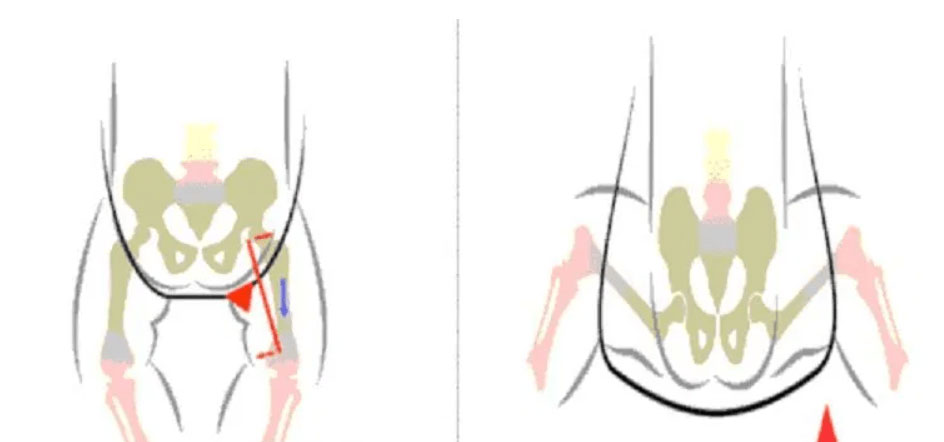
According to the International Hip Dysplasia Institute, for improper baby carriers (indicated in the diagram on the left): “Thigh NOT supported to the knee joint. The resulting forces on the hip joint may be inappropriate for prolonged use when infants have loose hip joints or hip dysplasia.”
For proper baby positioning (indicated in the diagram on the right): “Thigh is supported to the knee joint. The forces on the hip joint are minimal because the legs are spread, supported, and the hip is in a more stable position.”
Free Case EvaluationHip dysplasia is a condition where the bones of the hip joint are misaligned, instable, and/or loose. Other common names for the same condition include:
- Developmental Dysplasia of the Hip (DDH)
- Hip Dislocation
- Congenital Dislocation of the Hip (CDH)
- Loose Hips
The diagram on the left indicates a normal hip joint, while the diagram on the right indicates a hip joint with dysplasia, where the socket is shallow.
Free Case Evaluation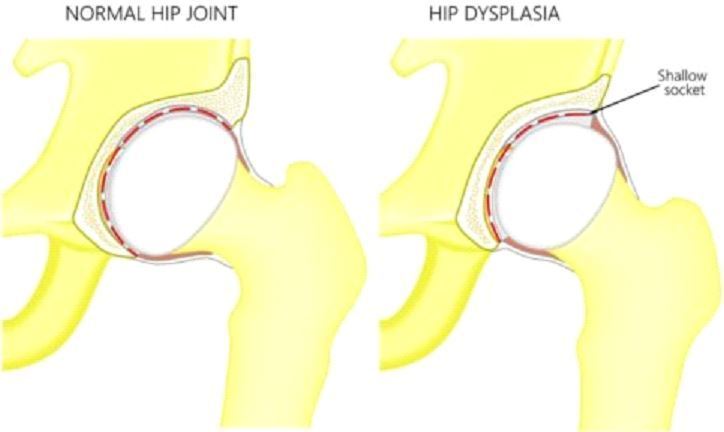
The most common signs and symptoms of hip dysplasia in infants and children include:
Asymmetry
Asymmetrical buttock creases can suggest hip dysplasia in infants but, like a hip click, an ultrasound or x-ray study will need to be done to determine whether the hips are normal or not. Continue reading about Asymmetry.
Hip Click
Hip clicks or pops can sometimes suggest hip dysplasia but a snapping sound can occur in normal hips from developing ligaments in and around the hip joint.
Limited Range of Motion
Parents may have difficulty diapering because their child’s hips can’t fully spread.
Pain
Pain is normally not present in infants and young children with hip dysplasia, but pain is the most common symptom of hip dysplasia during adolescence or as a young adult.
Swayback
A painless but exaggerated waddling limp or leg length discrepancy are the most common findings after learning to walk. If both hips are dislocated, then limping with marked swayback may become noticeable after the child starts walking.
Not sure if your child has been negatively affected by the use of a soft baby carrier?
Get a hip examination and X-Ray. If any signs of damage or harm are discovered, keep these records.
Free Case Evaluation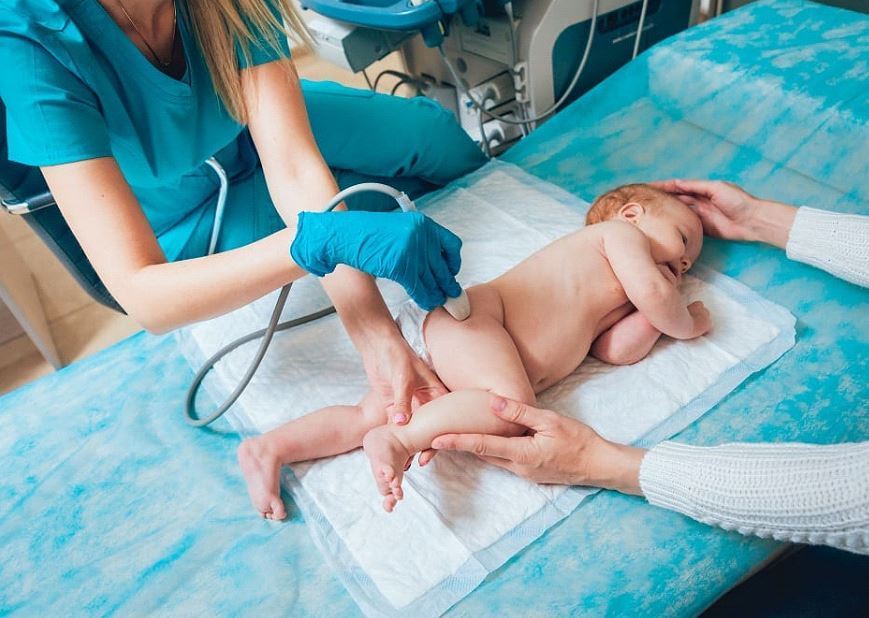
In addition to hip dysplasia, dangerous baby carriers have also been linked to the following:
- Minor laxity of the hip(s)
- Dislocation of the hip(s)
- Developmental Dislocation of the Hip (DDH)
- Avascular Necrosis
- Arthritis of the Hip(s)
- Subluxation
Every case is unique. Call Balaban Law and we will meet with you to gather information about child’s hip related issues and diagnosis if you have carried your child in a baby carrier and your child is now experiencing hip problems, or if you have frequently and extensively carried your child in any of the improperly-designed carriers listed above.
Free Case EvaluationWhen we speak with you, we will also ask if your child has experienced any of the following issues. These factors place children at a higher risk for hip dysplasia and may affect the outcome of your claim:
- Breech birth
- Premature birth (32 weeks or earlier)
- Traumatic fall or dropping accident
- Congenital hereditary hip issues
Even if your child has experienced any of the above issues, they do not necessarily disqualify you for a claim against a baby carrier manufacturer. As experienced trial lawyers, Balaban Law will fight for you and the compensation you deserve if your child has been harmed by an unsafe product.
Free Case EvaluationJust because a product is on the market, it does not mean the product is safe for use. Children’s products are regulated by the Consumer Product Safety Commission and must comply with the requirements stated for each type of product. The requirements for baby slings and carriers address certain types of potential dangers, mainly the danger of a baby falling out or being poisoned by the material of the product.
Baby carrier regulations include:
- Strength of fasteners and straps
- Full support of the child
- Safety of leg holes
- Flammability requirements
- Requirements for amounts of lead and Phthalate in product material
- Labeling and registration requirements
However, there are no regulations for how babies should be positioned in carriers and slings. These products and warnings failed to take into account the negative effects soft carrier products can have on a child’s body during their early stages of development.
Even though the government does not legally require proper hip positioning for baby carriers, manufacturers of baby products have a duty and responsibility to ensure their products are safe. Sadly, many manufacturers sell their products without doing sufficient research or in some cases, despite the research– in order to make more money, at the expense of your child’s health and safety.
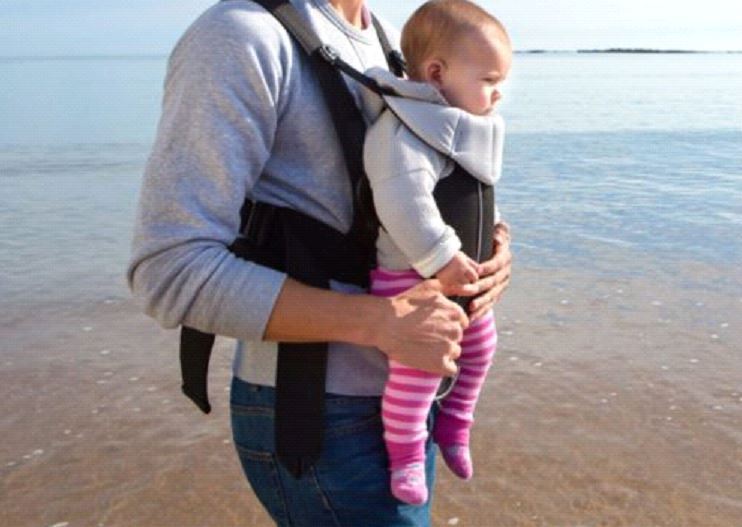
Even though the government does not legally require proper hip positioning for baby carriers, manufacturers of baby products should still do their part to ensure their products are safe. Sadly, many manufacturers either sell their products without doing sufficient research or in some cases, despite the research–all in order to make more money, at the expense of your child’s health and safety.
Free Case Evaluation